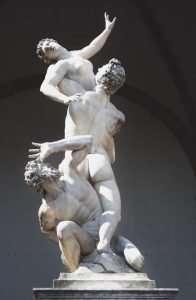Rococo art is an art style that was popular during the 18th century. Rococo evolved from the Baroque style and was replaced by the neoclassical style during the French Revolution. Rococo artists were inspired by certain themes, like nature, mythology and religion. They also liked to use ornamental designs, asymmetrical compositions and curves.
There are many famous rococo artists that made a great impact on the world of art in their time and are still admired today. These 3 rococo artists had a huge influence on European art and culture.
Rococo is a French word and it means ‘over the top’. The rococo art was over the top and highly ornate. This style was popular during the 18th century and the peirod of Baroque.
The rococo art has three famous artists that are called Boucher, Fragonard and Watteau. These artists were extremely famous in their time. All three of these artists were French and they created their masterpieces in France during their lifetime. These artists were among the best at what they did. And now all of their works are popular tourist attractions, but also priceless treasures for art collectors around the world.
The Rococo style was the dominant form of painting in France between 1720 and 1780. The style was characterized by light, bright colors; a fluttering, decorative style; and a focus on details over narrative. Rococco artists often painted scenes of romance, love and courtly intrigue.
Artists like Jean Antoine Watteau and Francois Boucher were the most famous rococo artists during the 18th century in Paris. They were both members of the Royal Academy of Painting and Sculpture, which was an official art institution in Paris during the 18th century.
Towards the end of the 18th century, Rococo art gave way to Neoclassicism, a new movement in art that rejected the frivolity of the Rococo style and favored more serious themes, such as those found in Ancient Greek and Roman history.
Rococo art is an 18th century art form characterized by lightness, elegance, and complexity of design. Rococo artists were known for their paintings, sculptures, and decorative arts that were often lacy, asymmetrical, and playful in nature. The term “rococo” is derived from the rocaille ornamentation characteristic of the period.
Towards the end of Louis XV’s reign (and during the reigns of Louis XVI and Marie Antoinette), the tastes in France began to change. Artists like Jean-Baptiste Siméon Chardin and François Boucher started to produce more realistic art depicting ordinary people and still life. Rococo art became less popular in France, but was still widely appreciated by collectors in Europe and America.
Rococo art is a style of art that was popular in Europe and the Americas in the mid-to-late 18th century. Rococo is French for “baroque” which means “extreme”. The term was first used by art critics to discredit the then-dominant Baroque art form, but it has since come to be accepted as a style of art.
Towards the end of Louis XIV’s reign, his court’s taste for elaborate, theatrical decoration gave way to a lighter touch and a more ornamental style. The term “rococo” came from the French word ” rocaille “, meaning rockwork or shellwork. It was first used to describe the ornate decorations found on Louis XV’s palace at Versailles, but eventually became applied to architecture, furniture and other decorative arts.
The Rococo had lighter colors than what is traditionally considered Baroque art. Instead of using darker colors such as reds, browns, and blacks, Rococo tended to favor lighter colors such as pinks, light blues and soft greens. Rockwork became very popular during this time period. This type of ornamentation was created by carvers with sharp tools such as chisels. They would cut away at rock
In the early 18th century, it was a time of enlightenment. It seemed like everything was about to change for the better. The arts were beginning to be seen as an important part of culture again, no longer seen as frivolous and purely decorative. This new attitude was called the Rococo style.
Rococo is known for its curving lines and its ornate design. It is known for being delicate and light-hearted, with a very feminine feel. It is usually femininely decorated with lots of flowers and plants, or even furniture that looks like it belongs in a lady’s chambers. No other style can match rococo’s elegant look, which is why it has remained popular throughout the years.
It was so popular because of this feminine look that Rococo became the favorite style of several European royal courts during the 18th century. It could be found in places like France and Italy, but it was most popular in Germany.
Towards the end of the 18th century, Rococo began to fall out of fashion. With this change came a shift in art styles throughout Europe that would soon lead to Romanticism, but there were some artists who continued to work in Rococo until near the end of their careers.
Rococo art is a style of art and decoration that first appeared in France during the 18th century. Rococo then spread to Central Europe, most notably Vienna and Prague, where the style was transformed into “Baroque” (the same word in French and German). Examples of this can be found in the capitals of the Holy Roman Empire and in many princely residences.
The word Rococo comes from the French rocaille (“rockwork”), a combination of the words roche (“rock”) and coquilles (“shell”). This was suitable for the extravagant style, which displayed a profusion of shells, something which became a design theme in itself. The style was characterized by exaggerated motion; it aimed to capture naturalistic movement and was often used in theater set designs. The colors lightened and paintings began to feature pastel colors instead of dark tones.
Its characteristics are:
Thin lines, especially those made by drawing rather than painting
Graceful, light figures
Curls and undulating lines – both straight or curved
Delicate colors, such as pastels
Small patterns that usually overlap each other (trellis) or are arranged so as to lead the viewer’s eye across the canvas
Although Rococo is


